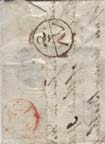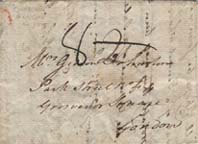Eunice and Ron Shanahan have shared with readers of the Victorian Web this material from their website, Letters from the Past. Click on thumbnails for larger images.
Postal Marks and Dating the Letter

This letter is one that I have been unable to date exactly. There are no years on the postmarks, or the watermark, and the writer John Johnstone simply marked it as "Denovan, 2nd August". The usual way of checking is by the postal markings, but the two Bishop marks show only the day and month: the Scottish Bishop Mark of the type in use 1725 -1806 AU over 4 bisected circle in red, applied in Edinburgh, and the London Bishop mark of the type in use from 1721-1787 AV over 8 black bisected circle. So the latest it could be is 1786, as the postmark which included the year was first introduced in London on 1st May 1787.

The letter is addressed to Mrs Gideon Johnstone, Park St, No.4, Grosvenor Square, London. This runs south from Oxford Street and into Park Lane — part of it was built in the 1720s, part in the 1770s, so that fits the time frame.
Sometimes the watermark on the paper includes a date, but this one is a crown over a shield with a hunting horn in the middle and the letters L V G but no date. This was the mark of a Dutch paper maker Lubertis van Gerrevinck, who was also a factor for importing French paper through Holland into England, there is evidence that these initials may have been used by some English paper makers as a kind of 'paper standard', so that cannot be used to date the paper more precisely. I have a friend in Holland who was extremely peevish that he could not find out any more information as he lives very near a paper mill which is still associated with the name Gerrevinck!
However, the next clue I would look for is the postage charge, in this case a '2' which has been crossed out and substituted by an '8', signifying eightpence. This helps to pin the date down as from 1711 to 1765 the rate from Edinburgh to London was 6 pence, but the Act of 1784 increased the cost by 2d for distances over 150 miles, and Denny is 427 miles from London. So the letter would have to have been written between 1784 -86. I can only guess that the 2 was put on originally to cover the cost from Denny to Edinburgh, but this was amended to cover the cost of the whole journey from Denny to London.
The Letter
So now to the letter, which sounds very pompous in view of the fact that it is written to his sister-in-law. Of course, like present-day e-mails, because of the lack of intonation, it could sound very different if it was spoken and not written. I have transcribed it as it is written with many of the words capitalised, which was the custom for a good many years — but although many of the words use the long 'S', which looks a bit like the letter 'f' — e.g. 'defire' for 'desire', or 'fent' for 'sent' — I have not shown it like that, as it is confusing to read. It begins very formally:
Dear Madam,
Your letter to our sister mortifies us exceedingly. We had flattered ourselves in the hopes that poor Gideon would have had strength to float him to Carron Shore instead of a Trip to Bath — his fate is hard, but he bears it with a Patience becoming his tried spirit — and ye love and attention you have shown him during so long an illness deserve a high place in the character of the Good Wife you wont to tantalise me with.
The reference to Carron Shore is to the river Carron (Denovan is close to the River Carron). He suggests his brother Gideon could have come to stay at his country home, instead of going to Bath Spa. There is an entry in a Gazetteer of Scotland in 1882 for Denovan as a village and mansion in the northern vicinity of Denny Stirlingshire, and in 2000 (about 200 years later than this letter was written), it is still there.
I am now at Denovan which grows every day more beautiful by my Planting and Improvements. James the gardener regrets much that his labor & fine crops will have none to praise them. Nevertheless, if Gideon gets his feet again, I think Bath, nor its environs, will not keep him, and James may persist in doing one thing or another.
Of your neatness & attention to my ornamentals, I have dayly proof before my Eyes here & find myself still further beholden for the arrangement of those in Park Street.
The next paragraphs suggest that Mr and Mrs Gideon Johnstone are living in the property, which has been leased unfurnished, and that as the lease is due to end, they have to make arrangements about the furniture. The reference to "the Driping Stone" is a mystery too, as the Oxford English Dictionary defines it as an architectural term referring to a projection on a building to protect the parts below from the rain!
I fear you may be putting yourself & Gideon to inconvenience by moving on account of the expiration of my Lease. That happens not till 7th September I believe & if it were agreeable to you to continue longer, it is probable Mrs Galatin wd be ready to accept of you as Tenants by the Month, or Week, as most convenient, and in such case the furniture need not be sent off till your convenience.
I sent a list inclosed to Gideon of such things as I thought might be worth sending down, the other articles would be very expensive in Freight & as Mrs Galatin declines taking any of them, if there be any of them that could be of use to my brother George I would be glad he had them, (The Driping Stone particularly) & remainder might be committed to the care of Mr Dingwall the upholsterer, son of Alex Dingwall — or rather to Mr Sykes to put up in one of my houses in Leadenhall Street, that will I hope be soon ready to receive them by the removal of a tenant who will pay no rent, and in this way probably they may turn to the most use & advantage. The expense of a sale wd sink them.
Note: the 1780 directory lists Sykes and Hyndle, upholsterers in Shoreditch, which is near Leadenhall Street. I wonder if the upholsterer Dingwall — worked for/was apprenticed to them. That MIGHT explain why Sykes rather than Dingwall could be entrusted with the goods.
He closes the letter with abbreviated greetings
With my best wishes to my dear br, I am dr Madam
your faithful & obedt S,
John Johnstone
Denovan 2nd August
There are no postmarks to show the letter originated from Denny, but as the Edinburgh Bishop mark is two days after the letter was dated, it seems a reasonable assumption. But I was surprised that it took four days from Edinburgh to London, as the recognised time for that journey was 3 days. The Time Bill of 1797 lists the departure from Edinburgh at 3.45pm and arriving in London 57 hours 25 minutes later.
References
Alan W Robertson, 'Great Britain Post Roads Post Towns & Postal Rates 1635-1839'
Willcocks & Jay, 'The British County Catalogue of Postal History — London'
Edmund Vale, 'The Mail-Coach Men of the late 18th Century'
In addition, I am indebted to contacts in Britain — Mark Harris, Val Wilson and Judy Olsen for background information.
Last modified 26 May 2010